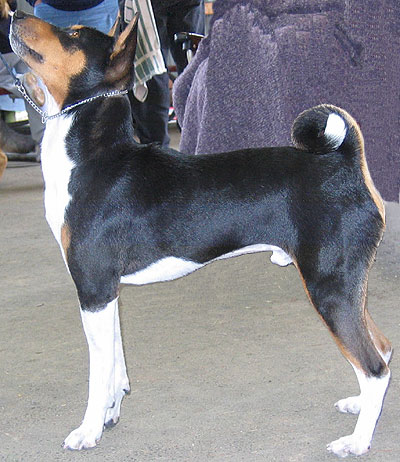The Basenji is a very ancient breed. It has been a native of Africa since written history began. This unique dog has characteristics which are quite individual to the breed and are not found in any other domesticated dog. For one thing, it is considered a barkless dog, it "yodels" or "purrs" when contented and "wails" when distressed. The Basenji is more catlike in some of its mannerisms than it is dog-like. It is a very clean dog and very light on its feet. I have personally seen a Basenji leap into the air and catch a bird in flight...more than once. Furthermore this dog does not stop at birds, it is quick to catch any rodents and will even eat earthworms with delight.
The Basenji's color is quite clean. Red and white, black and white, tri-color and brindle or tiger-stripe are the accepted variations. The coat is smooth and colors appear very glossy. The face has wrinkles which give the dog a worried expression which is quite appealing. The ears are upright, the tail is a tightly curled "doughnut" over the back. The feet are tight and round and the entire look is one of exceptional grace and balance. The Basenji is a small dog standing about 16-17 inches. Unlike most domesticated dogs, this is a breed which only goes into heat once yearly, having puppies usually during October to December.
In Africa this little dog is considered a hunter's helper, it will help the beaters by driving the prey into the nets. It is independent and will catch its own prey as well as do the driving. It can be considered both a sight hound and a scent hound as it uses both of these attributes quite successfully.
Because of its quite independent heritage the Basenji can be a handful for a novice owner to train. However, those who take the time will find that it is a wonderful companion and a delight to own. It is generally reserved with strangers but willing to accept neighbors and friends. The Basenji is very playful and highly intelligent and because it is a naturally clean animal it is fairly easy to housebreak. A fenced yard is a necessity because the Basenji is quite aware of its environment and will investigate everything that happens in its surroundings and it is an exceedingly fast dog.
The Basenji in Europe and the United States were developed from a very limited gene pool. Consequently some recessive genes which are dangerous to the health of the breed have surfaced. Among the conditions are kidney disorders, intestinal malfunctions and retinal atrophies. Responsible breeders have made serious efforts to eliminate these problems with controlled breeding. In 1987 and 1988 two safaris were organized into the country of Zaire to bring out new bloodlines. The importation of these new lines helped to further increase the genetic pool and improved the general health of the breed.


